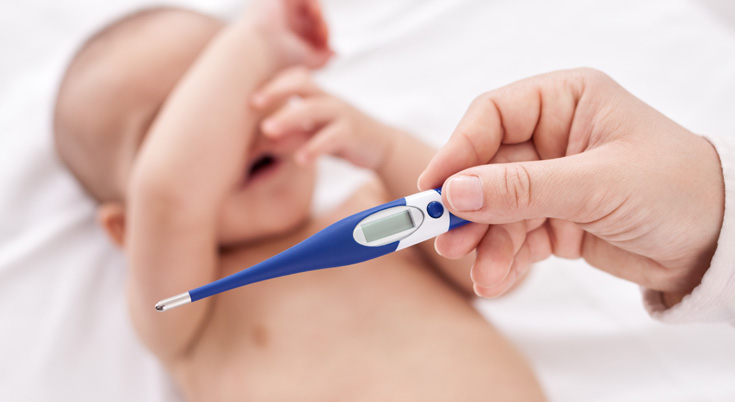

As a parent, you may experience being worried and clueless on what to do upon seeing your baby flushed, hot, and sweaty. “Should I get the thermometer or call the doctor right away?” A high temperature can be an indication of a range of possible illnesses or concerns. When your baby suffers from a temperature increase, ensure you know how to manage a high baby temperature.
It can be frightening when your baby’s temperature rises, fever itself causes no harm and can actually be a good thing – it’s often the body’s way of fighting infections. And not all fevers need to be treated. High fever, however, can make a baby uncomfortable and worsen problems such as dehydration.
Things to do:
- Keep the baby comfortable. If the temperature has reached 38.5 C or more, administer Paracetamol or Ibuprofen. Using Paracetamol is usually advised first and only add Ibuprofen if that doesn’t work within an hour or so.
- If the temperature is above 40.5 C, or they are shivering, they may have a bacterial infection. Consult your doctor if this persists for more than 5 days, particularly if your child is miserable.
- Seek urgent medical advice if your child’s temperature is high as 42 C. It is uncommon but is dangerous if it persists at this level for any length of time.
- If there are signs of serious illness associated with the fever, see your doctor.
What the temperature of your baby may indicate
Normal: For a baby (or child or adult), it is normal to have an internal body heat of about 36 to 37 degrees. Lower than 36 degrees means that your baby needs to be ‘warmed up’.
Low grade: If it is between 37 to 37.5 degrees. This is not regarded as a fever, but may be caused by your baby being overexposed to the sun, overheated, overdressed, being over-wrapped, or being in a hot a closed environment (room, car, etc.), particularly in a warm weather.
If this occurs to your baby and there are no other physical signs of infection, then it is best to remove some clothes or bedding. Take off any heavy or thick clothing, only place a sheet or light cover over them when sleeping. If their temperature comes down, then nothing else required
High grade fever: Doctors usually say a baby has a fever if the temperature rises to 38 degrees, or above. Learn what your baby’s normal level is by taking it a few times when he or she is well.
When to take your baby’s temperature
Fever happens to babies easily because the infant’s immune system is immature and not as effective in fighting off infections as it will be after three or four months of living outside the womb. So it’s important to learn how to correctly take your infant’s temperature and understand what signifies a fever.
You do not need to take their temperature on a regular basis. However, it can be checked every 4 hours for close monitoring. See age based guide to your baby’s fever here.
Monitor your child when the following symptoms occur:
- Hot skin, sweating a lot or has a rash.
- Runny nose, sneezing or coughing.
- Poor appetite or has refused more than one feeding.
- Pale or flushed complexion.
- Increased irritability
- Unusually fast, slow or especially noisy breathing.
- Baby rubs his/her ears, rolls head or screams sharply.
- Vomiting or diarrhoea or the stool has an unusual colour or odour. If there is diarrhoea, take the baby’s temperature under the armpit (axillary temperature).
Methods of measuring
Axillary (under the arm)
- Wipe the standard thermometer first using a tissue or a cotton ball with alcohol. Let it dry.
- Check if the armpit is dry before taking your baby’s axillary temperature. Insert the end of the thermometer (where you can find a distinct bulb) under your baby’s arm and hold his/her arm snugly against his/her body.
- Wait five minutes or until the electronic thermometer “beeps” before removing.
Normal range (axillary): 36.5 to 37.4 degrees Celsius
Rectal
- Wipe the standard rectal baby thermometer first using a tissue or a cotton ball with alcohol. Let it dry.
- Use a blunt tipped rectal thermometer.
- Put petroleum jelly at the end of the thermometer.
- Carefully and gently insert the thermometer into the baby’s rectum, no further than 1/2 inch.
- Hold the thermometer in place until it beeps.
Normal rectal range: 37.9 degrees Celsius or less
If you have further questions or concerns about how best to monitor your child during a fever, seek the advice of your doctor or maternal health nurse.






















